Technique, plus and minus
Ben Brooker: Adelaide Festival 2017: Backbone, Killer Pig & OCD Love, Gala
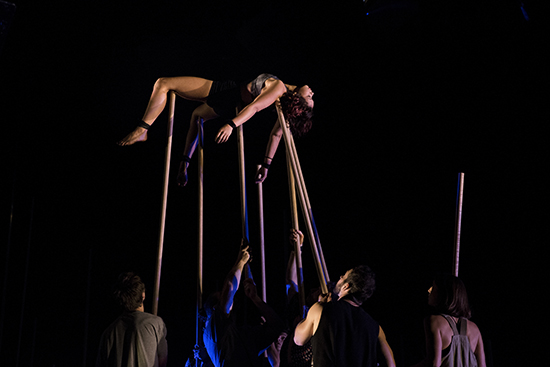
Backbone, Gravity & Other Myths, Adelaide Festival of Arts, 2017
photo Shane Reid
Backbone, Gravity & Other Myths, Adelaide Festival of Arts, 2017
Gravity & Other Myths, Backbone
Self-described as “acrobatic physical theatre,” Gravity & Other Myths’ muscular, stripped-back mode of contemporary circus has become a staple of the international fringe festival circuit since the company’s formation in Adelaide in 2009. Backbone, commissioned through the Major Festivals Initiative, marks the ensemble’s first work of scale and its Adelaide Festival debut. As such, the work has a deserved celebratory air. Parsing notions of what strength means and the various ways in which it is derived and measured, Backbone is a marathon of dexterity and endurance, answering director Darcy Grant’s question, “Are we strong enough to carry it?” in the affirmative.
The work starts with something like an in-joke. The stage is strewn with bodies, standing among them a knight in a full suit of armour and brandishing the sword with which he (or she) has just, presumably, slain them. It looks like the beginning of some high-concept piece of dance-theatre, as though this is what is expected of the company now that it has reached the big league. But then the bodies slowly animate, milling around and making small talk; familiar, phatic pre-rehearsal routines. The house lights remain on as costume racks are shuffled about, a series of different-length swaypoles erected upstage. Two musicians wait patiently on a dais.
Out of the hum of activity come distinct shouts of “ready!”—a preface to the evening’s first tests of physical aptitude as performers assemble into human columns up to four bodies high. There are somersaults and backflips and particularly athletic takes on a classic breakdancing move, the worm. It all feels like a primer for audiences who are not circus-savvy—a sort of physical lexicon—but it is also a display of concept, as direct a rendering of the idea of strength as any the work will offer, as well as a necessary preface to the mode of the work, each scene building in complexity from a base that Grant has described in an interview with RealTime as “circus Theatresports.”
The surface of the playing area is gradually covered with what looks like red-coloured earth, but is in fact a synthetic, granulated material that both frames and accentuates the movement of the performers as it becomes airborne. It’s ritualistically poured out of steel buckets—which then double, upended on the heads of the performers, as visual echoes of the knight’s helmet—and produces, in combination with Geoff Cobham’s lighting design that incorporates huge reflector panels, an elemental effect, suggestive of the idea of strength that’s tied to working the land. But other, more radical representations of strength are in play too, most obviously when the female performers—sometimes dressed in boiler- and pant-suits—dominate the work’s physical and conceptual spaces. There are moments, too, when the idea of strength is problematised, shading into violence and cruelty: a running fly-kick to the chest recurs throughout the work and performers are sometimes cajoled and struck as they attempt tricky balancing acts. In one uncomfortably funny scene, the familiar theatre game of counting as a group is subverted into an exercise in withstanding physical punishment as the ‘losers’ are struck across their exposed torsos by a fast-moving rope unleashed by the ‘winners’ as they perform a synchronised handstand.
It is, however, the displays of pure circus skill that linger in the mind—the adagio lifts and throws, the human columns that, at their extremities, seem to graze the ceiling of the Playhouse stage, and, especially, the work with swaypoles that culminates in the suspension of a performer, perhaps 15 feet in the air, on a single pole. Some of the material that hews closer to a sort of representational dance theatre—such as a scene in which a cargo net full of rocks is held aloft by a slowly diminishing group of performers while the others gather around and beneath it—looks a little weak in comparison.
Darcy Grant’s fluent direction and Elliot Zoerner and Shenton Gregory’s live score—an eclectic mix of drum loops, free jazz, club beats and flourishes that evoke Satie and traditional Arabic music—provide the foundation even when individual moments fall flat. For audiences who expect contemporary circus to trade on more than displays of skill there is sufficient conceptual and image-making invention here. But undoubtedly Backbone’s greatest strength is its physical virtuosity, matured to often breathtaking effect in the ensemble’s longstanding working relationships (up to 15 years) as well as their deep craft and trust in each other’s bodies.
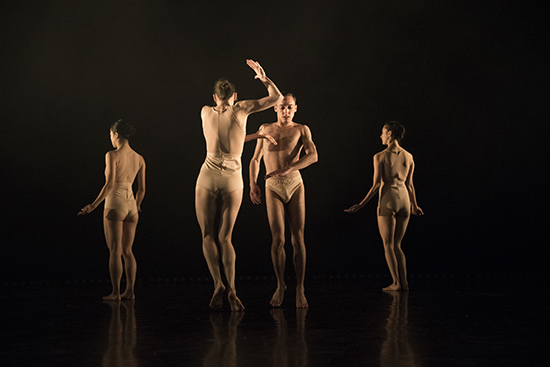
L-E-V, Killer Pig, Adelaide Festival of Arts 2017
photo Shane Reid
L-E-V, Killer Pig, Adelaide Festival of Arts 2017
L-E-V, Killer Pig and OCD Love
As with Backbone, Israeli dance company L-E-V’s double bill of short works, Killer Pig and OCD Love, vibrates with an uncompromising physicality. Choreographed by Batsheva alumnus Sharon Eyal and inflected with frequent collaborator Gai Behar’s Spartan, warehouse rave-like aesthetic—all dry ice and soupy light—both works foreground the dancers’ athleticism and exactitude. Long-limbed and sharply beautiful, they look—in Odelia Arnold’s drab, form-fitting undergarments and in concert with Ori Lichtik’s techno score—like models who have wandered in off the set of some dystopian reimagining of a Robert Palmer music video.
The first work, Killer Pig, is described in the program notes as “a glimpse into the place where the group originated.” The movement, hard-edged and robotic, begins sparely, working inwards from the arms and legs, taking in the shoulders and, finally, the pelvis and the heart, indicated by a dramatic two-handed plunging gesture. Positions and jumps from classical dance are transfigured and subverted, both an acknowledgment and disavowal of the company’s roots. A self-choking gesture hints at this dichotomy. Elsewhere, the choreography evinces a leering, almost monstrous quality—arms akimbo, shoulders raised, head thrust forwards—suggestive of a sense of inexorable growth, for good or ill. After a middle section of accomplished solos, Lichtik’s swampy, bass-heavy score—replete with DJ-style flanging and filtering—cranks up, pushing Eyal’s choreography towards its signature tribalistic group work.
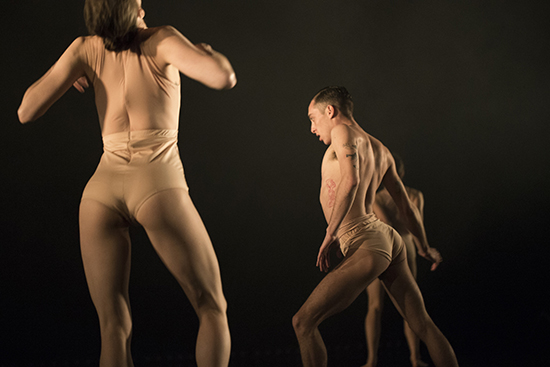
L-E-V, Killer Pig, Adelaide Festival of Arts 2017
photo Shane Reid
L-E-V, Killer Pig, Adelaide Festival of Arts 2017
The second piece, OCD Love, takes as its point of departure the slam poem “OCD” by Neil Hilborn, a video of which went viral in 2013 (current number of YouTube views: 12,694,040). Its leitmotif is a ticking clock that recalls, in its unerring regularity, Hilborn’s description of OCD’s “tics” and “constantly refreshing images.” The dancers continually draw our attention to what appear to be small points of focus offstage—presumably representative of the OCD sufferer’s familiar obsession with minutiae—while the debilitating nature of the condition is embodied as the dancers clasp their hands behind their backs. Perhaps, though, this is too literal a reading of Eyal’s choreographic vocabulary, which, as the work wears on, clarifies as a response to rather than rendering of Hilborn’s poem, positing the experience of OCD as a metaphor for love—its fixating and fine-grained quality, its capacity to possess and distort. A duet by two female dancers sums it up, full of mirroring and shadowing at first, then modulating into ecstatic coordinated leaps and, finally, dissolving into enmity and estrangement as one pokes the other in the eye.
In Hebrew, “lev” is the word for heart. It is perhaps a grave irony, then, that this is exactly the quality missing from these works. Each proves wearying in its relentless virtuosity, its monotonous insistence on weirdly machine-like erotics—the sexless sexuality of the high-end catwalk repurposed as underground art party exhibitionism. There is something inward-facing about Eyal’s choreography, a narcissism that invites voyeurism but not engagement. Lichtik’s unbroken and unsubtle scores—anonymous, pounding techno in the first work, sentimental washes of synthesised strings, played live to no obvious effect, in the second—compound a sense of bludgeoning, of being performed at rather than to.
These are also works whose superstructure is largely without shape, that accrue only in terms of the physical demands placed on the dancers. As the curtain fell at a seemingly arbitrary point during Killer Pig I found myself thinking of Theodor Adorno’s dictum: “The finished work, in our times and climate of anguish, is a lie.” When the same thing happened at the end of OCD Love, it simply registered as a failure of imagination, or perhaps a concession—what does it matter where these works begin and end, fading in and out of view like a good-looking stranger at a party?
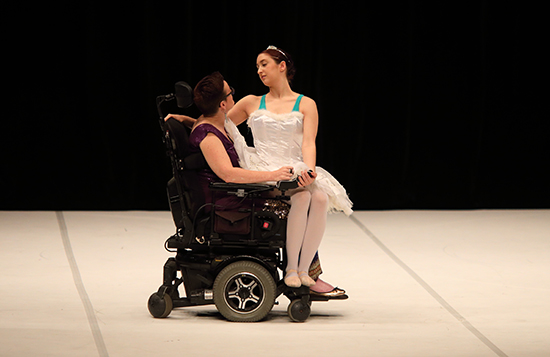
Gala, Jérôme Bel, Adelaide Festival of Arts 2017
photo Tony Lewis
Gala, Jérôme Bel, Adelaide Festival of Arts 2017
Jérôme Bel, Gala
If Killer Pig and OCD Love represent what happens when a surfeit of technique meets a deficit of spirit, then Jérôme Bel’s Gala presents as the opposite. As in previous works Disabled Theatre (2012) and Cour d’honneur (2013), Bel foregrounds local, non-professional performers in keeping with his long-term project of “deconstructing the institutional representation of dance” [program]. Here, Bel’s performers are, for the most part, amateurs who perform what look like partly or wholly improvised group and solo routines in a variety of classical and contemporary styles, each one identified by signs written in felt-tip pen on the pages of an old calendar: “ballet,” “waltz,” “Michael Jackson.”
The cast is diverse to the point of appearing “tick-boxy”—two children, a woman in an electric wheelchair, men and women of various ages, body types and ethnicities, one person with Down syndrome and a transgender performer. To the music of Giselle they execute haphazard ballet leaps with gusto, then combine into wonderfully incongruous pairings for the duets. In the section entitled “Company Company,” they swap costumes—a colourful, apparently self-selected miscellany of tutus, leotards and everyday clothes, glittering here and there with flashes of sequins and fluoro activewear—and earnestly attempt to follow one member of the group as they perform an improvised solo to a pop song. The results are lively and funny, not least because it is easy to see our own bodies reflected in those on stage in their effortful, intensely human striving, in their inevitable falling short and ultimate embrace of amateurism in its truest sense—a kind of love.
Bel has said that its his intention to “destroy the dream of the audience.” Gala opens with a long, silent slideshow of theatres from around the world. In this context even the grand ones—the Royal Opera House, the sweeping amphitheaters of ancient Greece and Rome—appear unimpressive, the photographs, many of poor quality as though hastily downloaded from the internet, reduced to the numbing banality of family holiday snapshots. The images flatten out, the theatres depicted in them draining of interest and individuality. Curiously, the rest of the work suffers a similar fate. While it is hard not to applaud the efforts of individual performers, the work’s diverse representation of bodies begins to resemble something like the United Colours of Benetton, offering diversity not as a departure point for exploring each body’s uniqueness but as a kind of homogenising fait accompli. None of the solo or group routines is allowed to develop beyond the superficial. Why, I wondered, isn’t Bel more interested in who these people are and what they can do than in using their presence alone to thumb his nose at a dance establishment that has, in any case, already received its fair share of post-structuralist critique? And why embed professional dancers like Larissa McGowan in the ensemble? Is Bel, for all his talk of destabilising old hierarchies, unable to resist having two bob each way?
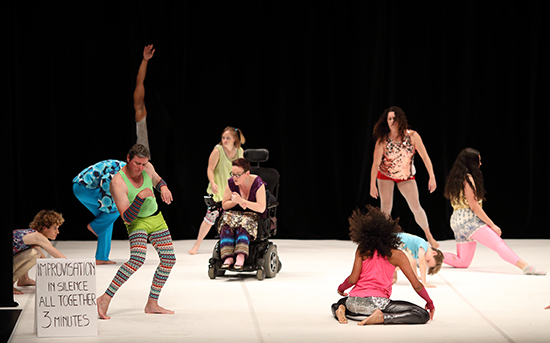
Gala, Jérôme Bel, Adelaide Festival of Arts 2017
photo Tony Lewis
Gala, Jérôme Bel, Adelaide Festival of Arts 2017
Adelaide Festival 2017: Gravity & Other Myths, Backbone, director Darcy Grant, designer Geoff Cobham, composers, musicians Elliot Zoerner, Shenton Gregory; Playhouse, Adelaide Festival Centre, 14-19 March; L-E-V, Killer Pig and OCD Love, creators Sharon Eyal, Gai Behar, sound artist Ori Lichtik, costumes Odelia Arnold; Her Majesty’s, 18-19 March; Jérôme Bel, Gala, conception Jérôme Bel, assistant Maxime Kurvers; Scott Theatre, Adelaide, 15-18 March.
RealTime issue #137 Feb-March 2017






